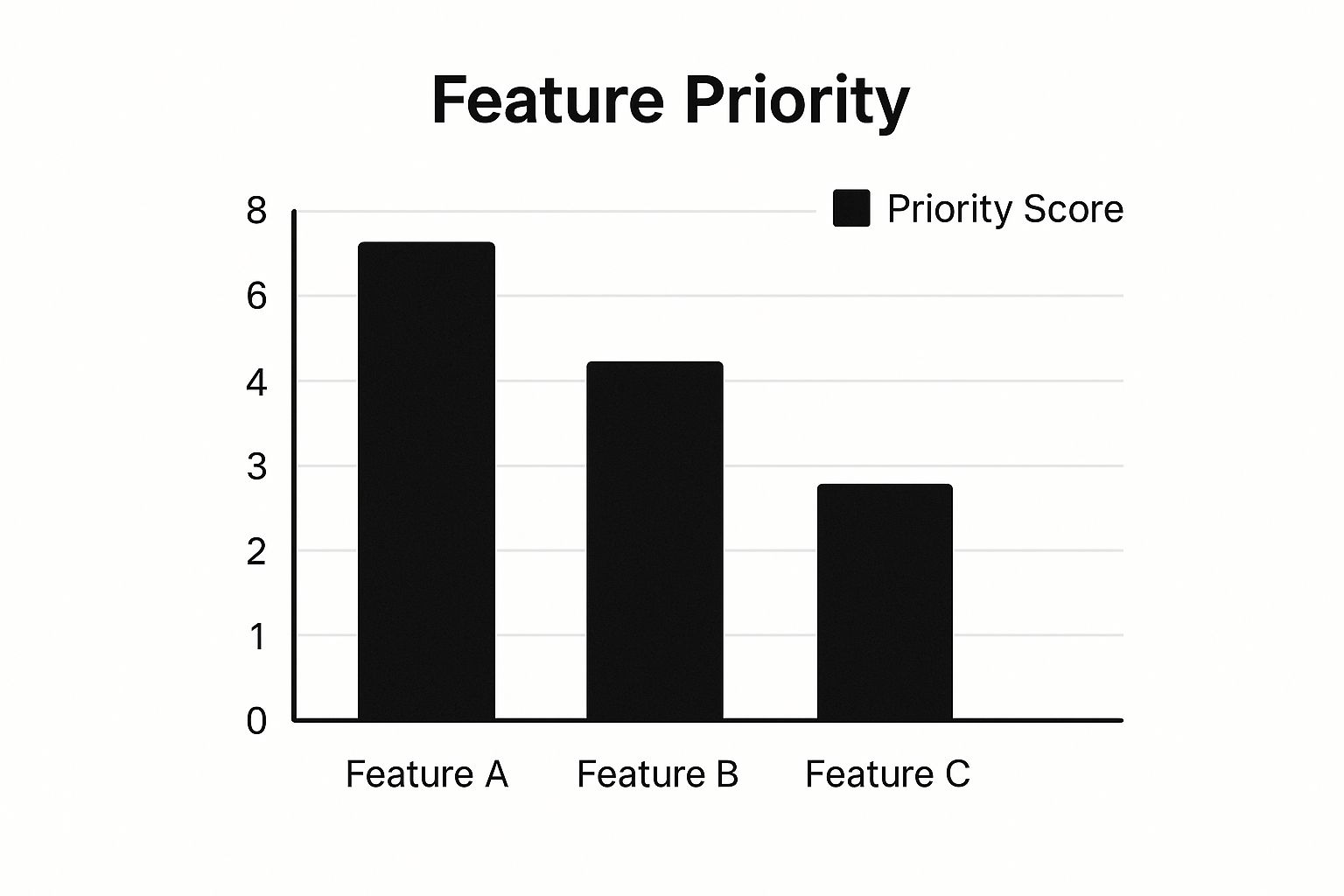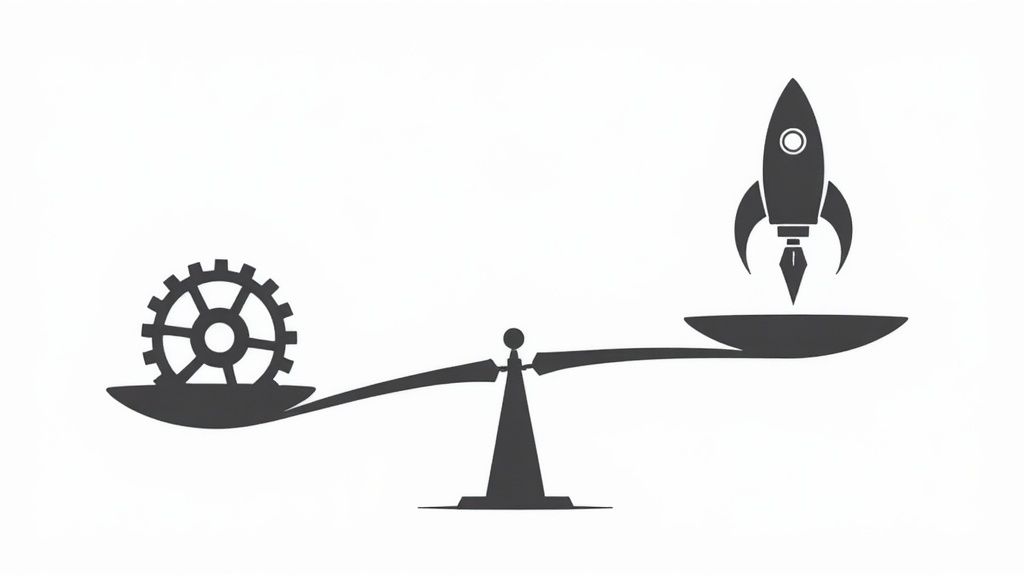How to Prioritize Product Features Effectively
Learn how to prioritize product features with proven strategies that boost value and meet customer needs. Improve your product planning today!

Why Most Teams Fail at Feature Prioritization
Prioritizing product features is crucial for product success. It directly impacts development efficiency, market positioning, and customer adoption. Yet, many teams struggle to get it right. This often leads to wasted resources, missed opportunities, and a product that doesn't reach its full potential. Why is such a fundamental process so challenging?
One key reason is the inherent complexity of product development. Teams constantly balance competing priorities. Sales teams might push for features they believe will close deals, while engineering might prioritize technically challenging but less market-driven features.
Customer feedback, while valuable, can also create a flood of requests that are difficult to reconcile. This creates a tug-of-war that can stall the prioritization process. In fact, 49% of product managers surveyed reported not knowing how to prioritize new features without valuable customer feedback. Want to delve deeper? Learn more about product prioritization frameworks.
The Pitfalls of Poor Prioritization
Another common reason for failure is a lack of clear strategy. Without a well-defined product vision and roadmap, teams can get sidetracked, chasing short-term gains over long-term goals.
This can lead to feature bloat, cluttering the product with unnecessary functionalities. It also creates market misalignment, where the product doesn't resonate with its target audience. Ultimately, development resources are wasted on features that don't improve the product.
The Importance of Customer Understanding
Finally, many teams underestimate the importance of truly understanding their customers. They might collect feedback, but without deeply understanding customer needs, motivations, and pain points, prioritization becomes guesswork.
This can result in features that are technically sound but don't solve real customer problems. Consequently, adoption stays low, and the product struggles to gain traction. Measuring the effectiveness of feature prioritization depends on understanding customer satisfaction. Looking for more ways to measure customer satisfaction? Check out this article on Effective Customer Satisfaction Measurement Techniques. Effective prioritization requires a strategic approach balancing customer needs with business goals and technical feasibility.
Breaking Through Prioritization Paralysis

Prioritizing product features is a constant challenge for product teams. The influx of requests from stakeholders, combined with the need to maintain a clear product vision, often leads to prioritization paralysis. This indecision can stall progress and cause teams to miss valuable market opportunities.
Identifying the Root Causes of Prioritization Challenges
One major challenge is data overload. Product teams are bombarded with information from customer feedback, market analysis, competitor research, and internal stakeholders. Sifting through this data to extract meaningful insights can be overwhelming. For example, analyzing hundreds of user feedback entries to identify key themes can be a complex and time-consuming task.
Another difficulty lies in balancing short-term wins with long-term product strategy. A feature that offers a quick boost might not align with the overall direction of the product. Finding the right balance is crucial for sustained success.
Prioritization also has an emotional component. It's tough to tell stakeholders that their favored features haven't been prioritized. However, open and honest communication is essential for building trust and transparency. Turning subjective opinions into objective decisions requires a structured approach and clear communication.
Feature prioritization is essential for product success. It involves ranking features based on factors like customer value, business goals, and technical feasibility. Effective prioritization helps teams allocate resources efficiently and focus on developing high-value features. Explore this topic further. This underscores the need for a robust prioritization framework.
Overcoming Analysis Paralysis and Making Decisions
To combat prioritization paralysis, product teams need strategies for objective decision-making. This often involves establishing clear evaluation criteria and using data-driven insights to justify choices. These criteria might include potential revenue, user engagement metrics, and alignment with the product roadmap. Read also: Reasons to Collect User Feedback.
Maintaining team momentum is also critical, especially when limited resources force difficult choices. Open communication and shared understanding of the reasons behind prioritization decisions are key. If a feature is deprioritized due to budget constraints, the team needs to understand the financial limitations and the strategic reasoning. This transparency builds trust and minimizes potential conflict. Ultimately, effective prioritization involves balancing competing demands, making tough decisions, and ensuring the product delivers maximum value.
Prioritization Frameworks That Actually Work
Prioritizing product features effectively is crucial for success. It's about moving from understanding the challenges to implementing real solutions. This transition requires adopting proven frameworks, enabling teams to make data-driven decisions that align customer needs with business goals.
The Power of Proven Prioritization Frameworks
Several frameworks have become essential tools for product teams. These frameworks offer structured approaches, helping teams navigate the complexities of feature prioritization. They help avoid analysis paralysis and empower confident decision-making.
Kano Model: This model helps understand customer delight. It categorizes features into basic needs, performance attributes, and delighters. This helps pinpoint features that truly resonate with users and boost product satisfaction.
RICE Scoring: This is a quantitative framework. It evaluates features based on Reach, Impact, Confidence, and Effort. RICE scoring gives a numerical score for each feature, allowing objective comparison and data-driven prioritization.
MoSCoW Method: This method categorizes features into Must have, Should have, Could have, and Won't have. It's a straightforward way to set clear boundaries and prioritize essential features for each product iteration.
Value vs. Effort Matrix: This visual framework plots features on a graph based on their perceived value and estimated effort. It helps identify "quick wins"—high-value, low-effort features—and avoid "money pits"—low-value, high-effort features.

The infographic above visualizes priority scores for three example features. Feature A has the highest priority (8), followed by Feature B (5), and lastly Feature C (3). This visual representation aids in quick comparison and prioritization.
To further explore these frameworks and how they compare, let's look at the following table:
Comparison of Feature Prioritization Frameworks
This table compares popular feature prioritization frameworks across several dimensions. These include complexity, data requirements, best use cases, and limitations. Understanding these differences can help you choose the right framework for your specific needs.
| Framework | Complexity | Data Requirements | Best For | Limitations |
|---|---|---|---|---|
| Kano Model | Low | Qualitative customer feedback | Understanding customer needs and identifying delighters | Difficult to quantify and compare features |
| RICE Scoring | Medium | Quantitative data on reach, impact, confidence, and effort | Objective feature comparison and prioritization | Requires accurate data estimation |
| MoSCoW Method | Low | Stakeholder input and consensus | Simple prioritization for each product iteration | Lacks detailed evaluation of feature value |
| Value vs. Effort Matrix | Low | Estimation of feature value and effort | Identifying quick wins and avoiding money pits | Subjective and relies on accurate estimations |
This table highlights the strengths and weaknesses of each framework. Choosing the right one depends on the specific context of your product development process.
Combining Frameworks for Optimal Results
While each framework has its own advantages and disadvantages, many companies combine several frameworks to leverage their strengths and mitigate weaknesses. For example, combining RICE scoring with the Kano Model offers a balanced approach, merging quantitative data with qualitative insights on customer satisfaction. This approach ensures features are chosen for maximum user delight while aligning with business realities. For a more comprehensive understanding of integrating prioritized features into your product strategy, check out this guide: How to Create a Product Roadmap. Adapting frameworks to your specific product context is key, and selecting the right combination requires careful thought regarding product maturity, team structure, and market dynamics.
Adapting to Evolving Product Needs
There's no one-size-fits-all prioritization approach. As products mature, team structures change, and market conditions shift, your prioritization strategies must adapt. For example, early-stage products might benefit from the Value vs. Effort matrix to quickly identify and deliver high-impact features. More established products may utilize RICE scoring for objective comparison of a larger number of potential features. This ensures the prioritization system remains relevant and valuable as the product evolves. This adaptability, coupled with a clear understanding of each framework’s strengths, empowers teams to prioritize features effectively throughout the product lifecycle. You might also be interested in: How to Master....
Letting Data Drive Your Feature Decisions

Building a successful product means going beyond gut feelings and the Highest Paid Person's Opinion (HiPPO). Instead, embrace data-driven prioritization. This means basing decisions on real evidence and insights, not just hunches. Effective product teams know how to use meaningful metrics, turning raw data into actionable strategies. This involves looking at potential features from different angles, such as analyzing user behavior and projecting the impact on the business.
Gathering Actionable Data: Techniques and Tools
Data-driven feature prioritization requires gathering information from a variety of sources. These sources should offer both quantitative data (numbers) and qualitative data (descriptions), creating a complete understanding of user needs and market trends.
Customer Interviews: Talking directly to customers provides invaluable qualitative data. These conversations can reveal user motivations, pain points, and unmet needs, giving you rich context for feature development.
Usage Analytics: Tracking how users interact with your product reveals usage patterns and highlights areas for improvement. Knowing which features are frequently used, and which are neglected, can significantly inform your prioritization decisions.
Market Research: Understanding the competitive landscape and current market trends offers crucial data for prioritizing features. This research helps you determine which features are in demand and how your product can stand out. For more on analyzing feedback, check out this guide on Customer feedback analysis.
Controlled Experiments (A/B Testing): A/B testing lets you compare different versions of a feature and measure their impact on key metrics. This gives you concrete data on which version performs best with users and delivers the desired results.
Establishing Clear Success Metrics
Before you start developing any feature, define clear success metrics. These metrics provide a benchmark for evaluating performance and determining if the feature meets its goals. For example, if a feature aims to improve user engagement, a relevant metric might be the average session duration.
One crucial best practice is avoiding common prioritization pitfalls. These include relying solely on isolated feature ROI, overemphasizing sales and support requests, and trusting gut reactions. A structured, data-driven approach, combining various prioritization models, is much more effective. Learn more about feature prioritization best practices. This data-driven approach leads to objective evaluation and informed decision-making, reducing the risk of developing features that miss the mark. By basing decisions on evidence, product teams can build customer-centric products that deliver real value and drive business growth. This approach ensures resources are invested wisely, and the product evolves in a direction that resonates with users.
Aligning Customer Desires with Business Reality
Prioritizing product features is a delicate balancing act. It requires aligning what your customers want with what's feasible for your business. This means understanding not only what customers request, but also the why behind those requests, and how they fit into your overall product strategy.
Identifying Key Customer Segments
Not all customers are equal. Some segments contribute more to your business growth than others. Identifying these key segments is crucial for effective product feature prioritization. For example, a small group of high-spending customers might generate significantly more revenue than a larger group of low-spending users. Therefore, prioritizing features for the high-spending segment could be more impactful, even if fewer users benefit overall.
Balancing Customer Needs with Strategic Imperatives
While customer feedback is invaluable, it shouldn't be the sole driver of your prioritization decisions. Your product vision and business model are also crucial. Data-driven decision making is key to making the right choices. For more insights, check out this article on data-driven decision making.
A feature perfectly aligned with customer desires might not be feasible given current resources or technical constraints. Conversely, some features might be strategically vital for long-term growth, even if they don't address immediate customer needs. This could include investments in infrastructure, security, or scalability. Balancing these long-term goals with short-term customer demands is essential for sustained success.
For example, combining the opportunity scoring system with the Kano model can help product managers create value for the company while satisfying customers. This balanced approach ensures product development aligns with business goals and user expectations, optimizing resource allocation and improving product success. Learn more about feature prioritization here.
Communicating Prioritization Decisions
Transparency is paramount when communicating prioritization decisions. Even if a customer's request isn't implemented, clear and honest communication helps maintain trust and engagement. Explaining the rationale behind decisions, emphasizing your commitment to customer needs, and offering alternative solutions can mitigate disappointment.
Frameworks for Feature Differentiation
Different features serve different purposes. Some focus on acquiring new customers, while others aim to retain existing ones. Understanding these distinctions is vital for effective prioritization. For instance, a feature simplifying the onboarding process might be prioritized for customer acquisition, while one enhancing existing functionality might be prioritized for customer retention.
Calculating the long-term value potential of different features can also inform investment decisions. This involves considering factors like customer lifetime value, potential revenue generation, and the overall impact on business growth. Carefully weighing these factors ensures that prioritization decisions contribute to the long-term success of your product.
Building a Prioritization System That Scales

Prioritizing product features isn't a one-off task; it's a continuous process. As your product and team expand, a scalable system is crucial. This means shifting from impromptu decisions to a reliable, repeatable process that can adapt to evolving needs. Building this system is fundamental to long-term product success.
Establishing Prioritization Rhythms
A prioritization rhythm is the regular schedule your team uses to prioritize features. This might be weekly, bi-weekly, or monthly. The right frequency depends on factors like your product’s lifecycle and the speed of development. Consistent rhythms help maintain focus and ensure prioritization doesn't get neglected.
A fast-paced startup might prioritize features weekly. A more established company with longer development cycles might choose a monthly rhythm. The ideal cadence balances responsiveness with strategic planning.
Structuring Effective Prioritization Meetings
Prioritization meetings should be structured and efficient. A clear agenda, defined criteria, and assigned roles are essential for productive discussions. This approach prevents meetings from devolving into unproductive brainstorming.
Thorough documentation is vital. A record of decisions, reasoning, and assigned priorities creates transparency and accountability. This documentation helps everyone understand the rationale behind feature prioritization.
Maintaining a Healthy Product Backlog
The product backlog houses all potential features. A well-maintained backlog balances new ideas with ongoing improvements. Regular grooming, removing outdated items, and ensuring clear feature definitions are vital. For further insights, refer to this article on managing a product backlog. This keeps the backlog manageable and focused on current priorities.
Creating Feedback Loops and Course Correction
No prioritization system is flawless. Feedback loops are crucial for validating decisions and making adjustments. This involves regularly reviewing the impact of prioritized features, collecting data on user behavior, and evaluating customer satisfaction. See this article on Product feedback loop for practical guidance.
Adapting to Different Team Structures and Growth Stages
Prioritization processes must be adaptable. Smaller teams may use simple methods like the MoSCoW method. Larger organizations may need more complex systems like RICE scoring. Choosing the right system depends on your team’s size, structure, and growth stage. A small team may prioritize features in casual discussions. A large, distributed team might use a dedicated prioritization tool like Trello and a formal voting process.
Fostering Cross-Functional Collaboration
Effective prioritization needs diverse perspectives. Product management, engineering, marketing, and sales should collaborate to ensure alignment between user needs, business objectives, and technical feasibility. Open communication is essential.
The table below details how to implement a sustainable feature prioritization process across different organizational sizes.
Feature Prioritization Process Implementation Guide
| Implementation Step | Small Team Approach | Mid-size Company Approach | Enterprise Approach |
|---|---|---|---|
| Define Criteria | Collaborative discussion | Cross-functional workshops | Formal stakeholder surveys |
| Gather Data | User interviews, basic analytics | Usage analytics, market research | Comprehensive data analysis, customer segmentation |
| Prioritize Features | Value vs. Effort matrix, MoSCoW method | RICE scoring, Kano model | Weighted scoring, cost of delay |
| Document Decisions | Shared document, meeting minutes | Dedicated prioritization tool | Integrated product management platform |
| Review and Adapt | Regular team check-ins | Quarterly review meetings | Formal post-implementation reviews |
This table outlines a scalable process, adaptable to various organizational structures. Implementing these strategies allows product teams to move away from reactive decision-making toward a system that consistently delivers valuable results. This proactive approach allows teams to focus on the features that make the biggest impact.
Measuring If Your Prioritization Actually Works
The real test of any product feature prioritization system is its impact. Does it result in a product customers love? Does it help achieve business goals? It's not just about shipping features; it's about understanding their real-world effects. This involves tracking specific metrics that show how effective your prioritization truly is.
Key Metrics for Evaluating Prioritization Success
Measuring prioritization success requires tracking both quantitative and qualitative metrics. These metrics provide a complete picture of how prioritization improves your product and drives business growth.
Development Velocity: How fast is your team delivering important features? A well-prioritized backlog can drastically improve development speed. It keeps the team focused on the most impactful tasks. For instance, consistently delivering high-priority features ahead of schedule indicates effective prioritization.
Feature Adoption Rates: Are users engaging with new features? High adoption rates confirm you're building the right things for the right audience. Low adoption suggests a disconnect between your priorities and user needs.
Customer Satisfaction: How happy are users with the overall product? Customer satisfaction shows whether your product meets expectations. While not solely tied to feature prioritization, it's a vital indicator of success.
Business Impact: Do prioritized features contribute to key business goals? This might include revenue growth, customer acquisition, or market share gains. Linking features to business impact demonstrates the value of your prioritization efforts.
Establishing Feedback Mechanisms for Continuous Improvement
Prioritization is iterative, constantly refined by feedback and data. Solid feedback mechanisms are crucial. You might find this resource helpful: How to master the Product Feedback Loop.
Post-Implementation Reviews: Review each feature's performance after launch, comparing it to the success metrics. This helps you learn what worked, what didn't, and how to adjust your approach for future decisions.
Impact Tracking: Continuously monitor the long-term effects of prioritized features on product growth and business success. This data provides valuable insights for future prioritization efforts.
Comparing actual outcomes against predicted results builds crucial organizational knowledge. This analysis refines your understanding of user behavior and market dynamics. It also reveals the accuracy of your initial estimations. Tools like the feature prioritization matrix are becoming increasingly popular. They allow teams to visually evaluate and rank potential features by importance and feasibility. Using these tools, companies can invest in features aligned with their business goals and user needs, improving product success. Learn more about product prioritization frameworks.
Learning from Mistakes and Adapting Your Approach
Even the best systems have occasional missteps. Features might underperform, or user needs might shift. The key is to view these as opportunities to learn. Analyzing underperforming features reveals valuable insights for better prioritization in the future.
Successful companies embrace these situations. They learn from mistakes, adapt, and continuously optimize their feature prioritization. This ensures their products stay competitive and relevant in the dynamic market.
Ready to improve your product development process? Saylo streamlines feedback, roadmapping, and communication, empowering your team to prioritize effectively. Visit Saylo to learn more.